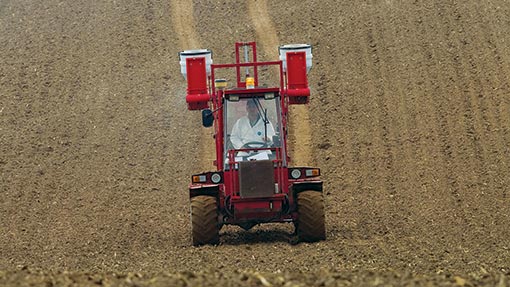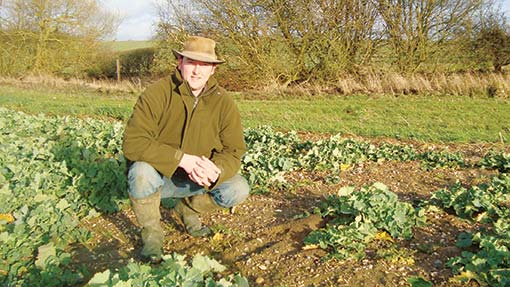Slug control after the withdrawal of methiocarb

The withdrawal of methiocarb for slug control later this year is unfortunate, but it doesn’t mean all is lost in controlling this damaging pest.
That’s the view of independent consultant Colin Myram, former spokesman for the Metaldehyde Stewardship Group, who believes there are still options for growers with the remaining two active ingredients, metaldehyde and ferric phosphate.
“Methiocarb has been a very good molluscicide,” he says. “It has traditionally been most used in potato crops, where there tend to be two critical control periods, although it’s suitable for use in other crops too.”
However, there’s no doubt the loss of methiocarb will add to the pressures on metaldehyde, he acknowledges, as metaldehyde has been detected in water supplies at levels above those permitted by EU standards and has been under scrutiny by the regulators for some time.
An industry-wide effort – spearheaded by the Metaldehyde Stewardship Group – to safeguard metaldehyde’s future while minimising the risk to drinking water has seen the introduction of application guidelines and limits, as well as other measures.
These are all designed to encourage responsible use and reduce its detection in water supplies.
Those restrictions include a maximum metaldehyde dose of 700g/ha/calendar year, with no more than 210g/ha being applied between 1 August and 31 December.
“And that’s the period when the biggest problems are anticipated once methiocarb has gone,” says Mr Myram. “The beginning of August to end of December window will have to be managed carefully, especially in a high slug pressure year.”
However, it can be done without compromising slug control, he believes. The use of a 1.5% metaldehyde product at an application rate of 4kg/ha allows 11 applications in one calendar year, he points out, compared with just three applications a year with a 210g product.
“So you could make eight applications on potato crops and three on the following crop, without falling foul of the rules.”
But the differences between pellets will be important, stresses Mr Myram, who warns growers will have to be aware of these. “Being able to make multiple applications will still be possible, providing your pellet choice is correct.”
See also: Eight of the best slug pelleters on test
The EU’s decision to revoke the use of methiocarb in slug pellets was due to the risk they posed to grain-eating farmland birds, explains the NFU’s plant health officer Don Prendergrast.
“We’re still waiting for the publication of the withdrawal timetable, but it is likely sales of methiocarb pellets will be allowed until the end of August, with growers having until the end of August 2015 to use up stocks.”
As all methiocarb pellets have been revoked, the most commonly used brands are Decoy Wettex and Draza Forte, he adds.
“But there are others too – Karan, Rivet and Huron from Bayer, Cobra from Interfarm and Zeal Plus from ChemSource.
“The ruling does not affect other uses of methiocarb, such as in the maize seed treatment Mesurol.”
Bayer CropScience, the manufacturer behind methiocarb, will not be challenging the decision, believes Mr Prendergrast, because it was supported by the majority of EU member states.
Potato crops are susceptible to slug damage from just before canopy closure up until the early stages of bulking, says Dominic Lamb of Chiltern Farm Chemicals.
Growers need to monitor crops carefully, he advises, as slugs can enter the tuber, creating holes on the surface and deeper in the tissue, affecting both yield and quality.
Once methiocarb has gone, keeping within the 700g limit of metaldehyde/ha/calendar year will be important, he stresses. “We don’t want to lose any more products. Growers will have to plan their pellet use carefully.”
Dr Lamb points out that those growers who elect to use a wet type 1.5% metaldehyde pellet have more opportunities to control slugs, including the autumn period. “Doing the maths, it works out that eight applications of 1.5% TR3799 pellets deliver a total of 480g of metaldehyde.
“That means you still have the maximum application of 210g to use from the beginning of August until the end of December.”
He adds that the 1.5% TR3799 pellet is the only low-dose metaldehyde pellet on the market. “It is specially formulated to work at much lower rates, so you need just 37µg to kill a slug. That compares with 205µg with standard pellets.”
Two pilot projects that advocate zero metaldehyde use on fields that have been identified as high risk got under way in January.
The chosen areas are the Mimmshall Brook catchment in Hertfordshire and the Avon and Leam catchment in Warwickshire, both of which feature heavy clay loam soils and are within safeguard zones that feed into water abstraction points.
For growers in the two catchments, there’s a voluntary commitment to use alternatives for slug control and avoid metaldehyde completely. But now that methiocarb won’t be in the armoury, they will be reliant on ferric phosphate for their future control strategies.
Alistair White (pictured below), who farms 450ha on land neighbouring the Affinity Water abstraction station in the Mimmshall Brook catchment from his Potters Bar base in Hertfordshire, is working with the project partners and was keen to be involved from the outset.
He has calculated that 60% of his arable land comes into the pilot scheme, so he will have to avoid metaldehyde on those fields.
“Metaldehyde has been our pellet of choice because it works and it is reasonably priced,” he says. “We have always tried to target bad areas in fields, rather than make blanket applications, and have followed the guidelines to the letter.
“But we will be changing our approach, in line with the project’s aims, as we want to be able to keep metaldehyde for use on our other land for the foreseeable future.”
The practicalities of switching between slug pellets in different fields is manageable and should be a two-minute job with a calibrated machine, he believes.
Mr White adds that it will be interesting to see how much of a difference is made by the test areas and whether the spikes of metaldehyde seen in water, especially in wet autumns, become a thing of the past. “It’s wheat crops following oilseed rape that have the biggest slug problem, even though they are always rolled. The oats don’t have a slug issue.”
Despite not using methiocarb much, he is very disappointed to see it go. “It takes away one of our options, at a time when we are restricting our use of others.”


